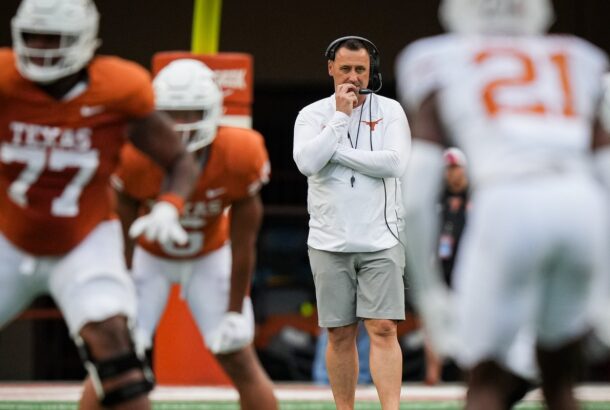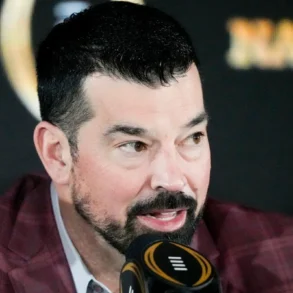Skip to content
Ad Disclosure

Spring games are non-essential.
There. I said it. Now you can’t accuse me of pretending that scrimmages with often confusing scoring systems and 1-hand-touch rules on opposing quarterbacks have a significant bearing on a team’s upcoming season. Good. That’s out of the way.
But as the anti-spring game trend has been echoed by high-profile teams like Texas, Ohio State, USC, and Nebraska — Matt Rhule was at the forefront of this 2025 pre-spring movement to ditch the televised intrasquad scrimmage — let’s remember that there’s a difference between being non-essential and being downright negligent. Spring games are not the latter. At certain places, they do serve a purpose. To ditch them universally would be negligent.
What do I mean by that? Spring game decisions should be made on a case-by-case basis.
In the case of Texas, I completely understand Steve Sarkisian‘s logic for passing on a spring game, which he explained during a recent appearance on “Up & Adams.”
It’s a fair point. Texas and Ohio State just played 16 games. If this were the 20th century, we’d consider that 1.5 seasons worth of games. Teams who make deep College Football Playoff runs in this new era would indeed benefit more from NFL-style OTAs. I won’t argue with that point.
USC didn’t have the same issue as Texas and Ohio State, but let’s be honest. The issue the Trojans are facing is much more about optics than they’ll ever publicly admit.
Sure, USC can spin that as “the times are changing.” But if there were more than 60,000 fans who were willing to show up to a USC spring game, that might be a different story. Nebraska had just that last year (and every year when official spring games have been a thing), but Rhule cited potential tampering in the post-spring transfer window as a negative impact that the Huskers’ televised spring game has had in the past.
“I dealt with a lot of people offering our players a lot of opportunities after that,” Rhule said (H/T FOX Sports). “So you go out and bring in a bunch of new players and showcase them for all the other schools to watch? Doesn’t make a lot of sense to me.”
While I’d argue that Rhule could do the same thing — and probably has at some point — one can understand his gripe. Losing a few guys off the 2-deep could be the difference in winning a game. When you’re a 6-6 program, yes, every win matters. That’s more important to a head coach than the potential blowback received from conference TV partners (I’d imagine there’s some of that going on behind the scenes).
But let’s back up for a second because this isn’t a cut-and-dry issue. Spring games have evolved in the TV contract era for a reason. They represent a rare opportunity to earn revenue during an 8-month offseason. As we near the revenue-sharing era — wait and see what April brings with the House v. NCAA settlement — that’s still providing value to the university.
At the same time, reduced spring game prices often serve as the lone in-person viewing experience for families who perhaps can’t afford a college football Saturday anymore. You’ve got schools like Tennessee who now charge a 10% “talent fee” for season ticket renewals. Mind you, that came on the heels of the Vols increasing ticket prices by 4.5% (H/T AP). It’s never been more expensive to be a fan. Abandoning the lone tradition that both generates revenue AND gives something back to the fans will push supporters away in some cases.
Some programs like Ohio State might not think twice about how that comes across, nor will it be concerned about “growing its brand” when it just won a national title. Not everyone has that luxury.
During the Lane Kiffin era at Ole Miss, the “Party in the Sip” branding opportunity has been a theme during its spring game/slam dunk contest/hot dog eating contest. It’s been an opportunity to showcase Kiffin’s fun program while bringing back Ole Miss royalty like A.J. Brown and D.K. Metcalf. At a time when the college sports calendar is void of high-impact events, there’s still value in that. With schools canceling spring games, you could argue there’ll be more value for those who do want to use it as a showcase if executed right.
And maybe this will sound like a dated perspective, but isn’t there still benefit to teams who want to compete and have fun with an end-of-spring scrimmage? Sure, you can simulate some of those things without a crowd and/or a TV broadcast but don’t tell me a closed practice is the same thing as having fans present and treating it like a real game. It’s still a way to evaluate position battles, and if a team has an uncertain quarterback situation at the end of spring camp (something that also feels like it’s decreasing), that’s the closest way to simulate game action.
That alone likely won’t be a dealbreaker for coaches when they make their spring game decisions. I get that. But we shouldn’t pretend that the only impact of an official spring game is negative.
Sarkisian said in that interview that “it’s gonna be a little bit of a different approach, but I think college football is changing right now, and we need to do a great job as coaches adapting to college football.” Nobody is wrong for saying that, including Sarkisian.
Just don’t pretend that the adapting of a few should become essential for all.
Connor O’Gara is the senior national columnist for Saturday Down South. He’s a member of the Football Writers Association of America. After spending his entire life living in B1G country, he moved to the South in 2015.
You might also like…
This post was originally published on this site be sure to check out more of their content.








